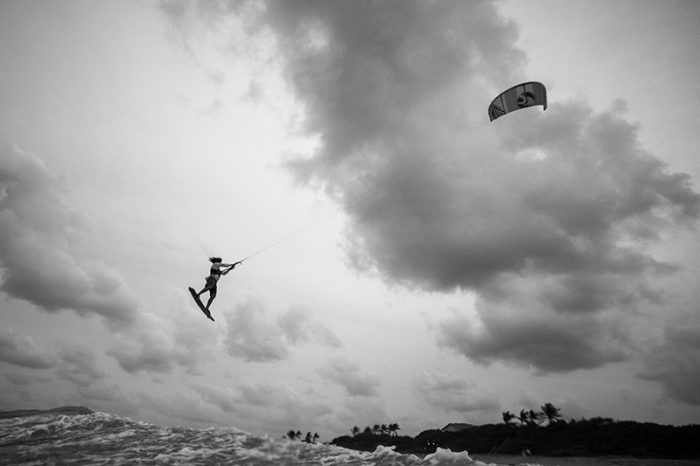By Jeremy Lund
This fall kiteboarding season has been one to remember. October proved to be a great month with more than 15 knots almost every day. November slowed down a little but still had some great days. With all this great wind came a very large shore break with strong rip currents and punishing waves. These conditions were great for some and too much for others. In this article, I am going to share a few tricks that may help you be more successful when riding in these conditions.
If you are trying to kiteboard in the ocean with direct onshore winds and a strong shore break, you should have already mastered riding upwind and tacking during more favorable conditions. One of the first things to look for when trying to break out through the rough surf, is the rip currents. These rips can be used to aid you in successfully tacking against the wind and large breakers. When I find a rip current, I will typically tack back and forth in the general area while edging slow and hard against the rip current, using its energy to pull me out. These rips are the same that have claimed many swimmers lives. Make sure to be very careful and have a full understanding of how to get out of them, in case you have to ditch your kite/board.
Next on the list is, “don’t try too hard”. Stay relaxed and let the conditions and the equipment do the work. Take your time and look for breaks in the waves. Wait for a good opportunity to break through the initial shore break. Those who are impatient are often humbly reminded of the power of the ocean as they become washed back ashore by a breaking wave. If this happens to you, stay calm, focus on your kite, go back to the beach, regroup and try again when you’re ready. Do not rush it!
As the waves become larger and more powerful, the above will not be enough. You will need to be a master of jumping and landing. There will be times in large waves when the only way out is up. Practice your jumps carefully and in calmer conditions or a flat water area. Jumping straight up and down is not what will save you in a large wave situation. You will need to know how to jump with good distance and land carrying speed. This allows you to ride away quickly after landing and get out of the way of the next wave. This is a technique that we often teach at my school (NewWaveKiteboarding.com) in a flat water scenario.
I remember when I was first learning to ride in direct onshore conditions with large shore break. It took many days of trying for hours until I could learn to break free of the initial shore break. All I really needed was a couple tips from a local and I broke free instantly. The combination of the above techniques will aid you greatly in our area if you plan to ride on the ocean side. Just make sure to pick your days. If you don’t feel comfortable swimming in it, you should not kite in it. As it’s often said, when in doubt, don’t go out.

FORECAST BY: Jeremy Lund
Lead instructor and owner of New Wave Kiteboarding
Email: Jeremy@newwavekiteboarding.com
Website: NewWaveKiteboarding.com
Find us at Sailfish Marina in Stuart, FL
(561) 633-9362




